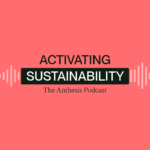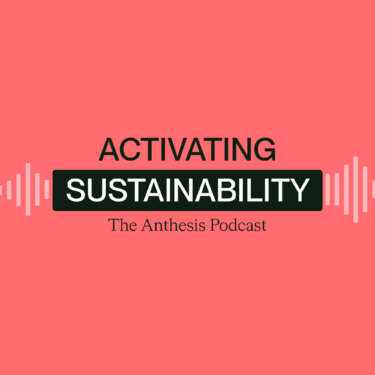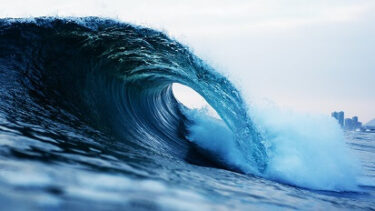
Speakers
Chris Peterson, Director
Dave Jaeckel, Principal Consultant
Related Topics
Share this episode
In this Activating Sustainability episode, our host Chris Peterson is joined by Dave Jaeckel, Principal Consultant with the Anthesis water practice, to discuss where water is at in the climate agenda, current and future efforts surrounding water, and outcomes from the 2023 UN Water Conference.

Read the transcript
Chris: Hello, and welcome to Activating Sustainability, the Anthesis podcast. I’m your host, Chris Peterson, and I’m really excited to be digging in on water as it seems to be in the headlines all the time this year. And you know, particularly this time of year with lots of changes in this space. So to unpack what’s happening and where things are going and how best to approach it, I’m really excited to be joined by Dave Jaeckell, who’s a Principal Consultant with the Anthesis Water Practice. Dave, welcome to the podcast.
Dave: Yeah, Thanks, Chris. It’s great to be here and to talk about water.
Chris: Awesome. Well, I know it is a deep passion of yours and it feels like it’s a big, forgive the term, watershed year for water. So, what is going on? Why is it such a focus at the moment?
Dave: Yeah, I mean water is all over the news these days and it’s kind of all, I guess, all I hear about. But I’m deeply immersed in the water world. I guess I can provide a little context around that: I live in the Western US, so in the West it’s all about water scarcity. That’s kind of what drives a lot of the conversations and it’s what always brings water into the news. And this year it’s kind of been the opposite. There’s been these atmospheric river events that have slammed the West Coast in California and it’s basically caused flooding and it’s caused reservoirs to fill back up and it’s been a very uncharacteristic year out there and it’s basically flipping this typical Western drought narrative on its head, and people are beginning to take notice. So one thing we know with water is that with climate change, impacts are going to be felt first within water, and we’re currently seeing that in the West. So the West is in this boom cycle with these record rainfall events and just a huge snowpack. And I think it’s important to note that one banner year of water doesn’t erase a history of dry years. So right now we’re in a 23 year old mega drought and we’re seeing basically ramifications of being in this water scarcity event through the Biden administration recently addressing the Colorado River crisis by making more post-water reductions to states. So, we we kind of have these two different narratives going on. We have on the one hand a ton of water that’s hitting the West, which is completely uncharacteristic. And then on the other hand we have historic water cuts to the Colorado River system and these are going to dramatically impact cities and users of water in the West. So I think people in the US are kind of scratching their heads saying what’s going on. There’s too much water, there’s not enough. What’s the deal?
Chris: Well that seems to speak to what you’re saying about climate change manifesting showing up first and water, right. Like everybody talked about the way we’ll experience climate change – that it will be these extremes. Within that, right. That certainly feels like, well, what we’re feeling. You know as you think about the US for sure, but as you look globally, are there kind of similar trends that’re being seen or experienced, around that?
Dave: Yeah, it’s not just the Western US where people are paying attention to water. And when we think about water globally, hundreds of millions of people still lack access to safe water and sanitation, which are basic human rights.These water issues are more pronounced in developing countries. For example, 70% of sub-Saharan Africa and far too many communities and other wealthy economies, they lack safe drinking water services. And these issues have been going on for the last half century and are only projected to get worse like you mentioned Chris would, as a result of climate change.
Chris: I know there was a large UN conference, just about a month or so ago. You know, what was that all about and what were some of the things that came out of that?
Dave: Yeah. So these water challenges we’re talking about at a global scale, the Water Conference came about as a result of this retrospective analysis on something called Sustainable Development Goal 6. So it’s part of these broader Sustainable Development Goals, which were created by the UN to address a number of different issues. So, in 2015, the UN set this goal to achieve clean water and sanitation for all by 2030, which is SDG 6. And when the UN reviewed progress towards the goal in 2020, they realized that 2 billion people in the world still lack access to safe drinking water in their homes, and a third of people did not have access to basic hand washing facilities. They basically realized that they were dramatically off track to achieving SDG 6 by 2030. That was, that was the timeline. Also because water is a cross-cutting issue and there’s 17 sustainable development goals and water touches on virtually all of them, they realize they can’t achieve other sustainable development goals without first addressing water. So, as a result of this retrospective analysis, the UN Water Conference in 2023 that we just attended, which was the first Water Conference in 50 years, was really an effort to speed up progress on meeting sustainable development goal 6, so it can be achieved by 2030. So that was kind of the catalyst behind the conference and it’s pretty wild that a water conference hasn’t happened in 50 years.
Chris: Yeah, it’s incredible. And I know you mentioned that you were at the conference. Would love to hear a little bit of kind of what was that like, what were some of the key outcomes from that? What stood out to you from that experience?
Dave: Yeah, basically it was a great conference. Anthesis was 1 of over 2000 participants. So there were a lot of folks there. And there was kind of the main UN conference where a host of NGOs and private stakeholders from all aspects of private sector countries etcetera, were meeting. And then there was, there were also these great offsite events going on throughout the city touching on a number of different topics all related to sustainable development goal 6. It was an amazing place to be for people involved in water like myself, and really the main outcome of this conference was the Water Action agenda. So, the Water Action Agenda, which was kind of billed as trying to be something around the Paris Agreement for water, didn’t quite get there, but that was the overarching goal. But the Water Action Agenda is a collection of all water-related voluntary commitments to accelerate progress from now until 2030 to meeting the 2030 agenda, which is basically sustainable development Goal 6. So what we saw was, there were 700 voluntary commitments. So unlike the Paris agreement, these aren’t binding commitments, These are voluntary. They were kind of aimed at turning this political momentum that we saw at the conference towards action and that was really inspiring. So at Anthesis, we worked with private sector clients and I think what was interesting about the conference was all of these private sector companies were just really interested in water and we haven’t always seen that. Mostly we see a lot of our corporate clients interested in carbon and kind of addressing climate change, which they should be. But as we know when it comes to climate change, impacts are felt first in water. So these companies are now feeling those impacts through water-related challenges, and they’re starting to do something about that, which is exciting.
Chris: Well, I definitely want to dig into the private sector piece first, but maybe just before we move off the UN conference as somebody that’s been so engaged in water for a long time. You know, did you walk out of that feeling like that was a miss or that that was the first step in some really critical steps that need to go forward with that.
Dave: I think it was a great first step in moving towards action. I think it was a mixed bag as well. Some people left the conference saying there was a lot of talk and you know, not enough action and commitments with teeth because they were voluntary. But, I think just having a conference in the first place was a major win. The last international water conference was 50 years ago. So I think just having a conference at the UN, getting people together, talking about water, what needed to happen and all the challenges associated was a major win and I think with water it’s really interesting when there’s boom times, there’s flooding and there’s lots of rainfall and water. People don’t care about water, you know, everything’s good. But when there’s droughts and water scarcity events or water quality that makes water not usable. Then people do care and they pay attention to water. So in a way, I think this conference is kind of like a scarcity time. Water is getting a lot of attention and when water has a lot of attention, you know, you have to do something about it quick before that political momentum and kind of public will goes away. So I think there’s a lot of momentum right now and it’s a great time to be in water and to get things done.
Chris: Well and, maybe just picking up on that piece, you know I know that there were a couple of pieces that we see coming in place such as some of the standards like I know the Science Based Targets Initiative is starting to look at water, guidance similar to TCFD, etcetera. Maybe could you speak about some of those things which are maybe kind of harvesting in this good time of awareness to establish those foundations so that we don’t lose sight of this as we go forward?
Dave: Yeah. Well, you mentioned Science Based Targets for freshwater. So, the preliminary guidance for that initiative is happening in May 2023. So we’re seeing a lot of interest in basically moving toward science based targets and that’s gonna be a really interesting initiative because for a lot of our private sector clients it’s going to push the focus not just on say a companies direct operations and what they’re doing there, but it’s also going to make companies aware of their upstream suppliers and their supply chains generally because that’s where all their water impacts are and that’s where they’re using the most water. I think what we’re gonna see from a corporate lens, too, is companies start to address their upstream impacts in water and this is all kind of following the carbon trajectory where water is kind of 5 to 10 years behind carbon and we’re seeing that right now. So there’s new initiatives like Science Based Targets for freshwater. You have CDP, CDP water, which a lot of our clients disclose to. They’re kind of aligning their methodology more with Science Based Targets for freshwater and that’s just geared towards upstream suppliers and key commodities. So you’re gonna continue to see companies just address impacts throughout their value chain and that’s being pushed right now, you know, in this boom time for water. A lot of the conversations for example that we heard at the conference were centered around collective action. So, doing more with partners in a shared water basin. So in areas where you’re surrounded by other companies that are doing something around water as well. So kind of taking what you’re doing and expanding it into a broader collective effort. There was a lot of talk around that. There was also a lot of talk around using digital tools, so companies like Google are partnering with organizations like the World Resources Institute to develop tools like Global Water Watch, which is going to use satellite data to see in real time what surface water is looking like around communities that some of the companies are operating in so you can get more of an idea of actual on the ground water risk,. So, that was pretty big. And then we also saw a lot about using nature based solutions to address water challenges. So, those are things like harnessing nature to improve water quality, improve water quality. Key components of nature based solutions are there, they offer multiple benefits so companies can simultaneously address carbon goals and also double dip into water as well. So using those nature based solutions for multi-benefit projects and then because this conference was centered around sustainable development goal 6, really the bread and butter of that is going to be providing clean water access, sanitation and hygiene to facilities that you operate or have suppliers in and those communities. So really, taking care of that as just an overarching goal in helping meet sustainable development goal 6.
Chris: Well, maybe that’s a good pivot to the kind of corporate view of this, right? And I know we’ve had the chance to talk previously on an earlier podcast around water strategy and would love to hear your perspective on, with all this attention, with the activities that are going on, etcetera, where do you see corporates today? And then what are some of the steps you recommend organizations were thinking about as they have looked to take action, move beyond maybe the talk piece of it?
Dave: Yeah. So in terms of where corporate water stewardship is going and where we’re at, we have this really engaged robust water stewardship community that has developed guidance, stocks, frameworks and tools to help companies kind of move along their journey. And like I said the newest of these is going to be the Science Based Targets for freshwater initiative that’s gonna be released on May 22nd. I think the consensus is that companies know what to do around water and these new initiatives are just expanding upon that. Basically these journeys kind of focus on three stages. One is: understand how fresh water is going to be material to your business and understand the basins you impacted depend on.Two is: kind of create water stewardship plans and set targets. And then implement those water stewardship plans and that collectively. And then three is, assess and verify actions and then report and disclose. So those are frameworks that we use that will probably continue to be used in the future. And I think where things are going with water stewardship is more like I said upstream suppliers as a result of initiatives like the Science Based Targets for freshwater, focusing on water access, sanitation and hygiene. So really expanding when you’re doing risk assessments, or when companies are looking at their suppliers and their direct operations, making sure those basic human rights are met so that people can live their lives without having to go look for water, or suffer as a result of poor sanitation and hygiene, that’s pretty critical. Another topic I think that’s emerging is environmental justice. So looking at communities adjacent to a company’s direct operations or supplier facilities and then looking to see where there’s overlap between kind of disadvantaged communities that have suffered as a result of, you know, environmental pollution or are located next to a highway or things like that and giving back to communities and prioritizing those communities to focus water-related efforts on, we’re seeing that more with some of the companies that we work with. Using better tools and data, so getting a better picture of what’s going on around on the ground for a company’s operations, and kind of figuring out what to do based on the best available data. Focusing on collective action in 100 key basins. So this is an effort piloted by the CEO Water Mandate and Water Resilience Coalition, which are kind of leading thought leaders around corporate water stewardship. And there’s really a focus on getting a bunch of companies together and then looking at key basins where a lot of these companies’ supply chains are located, and then implementing collective action water projects to help address the key water challenges. That’s a big part of what companies are looking to. And then, using nature based solutions that are kind of integrated into larger ESG strategies. So if you’re looking at, for example, a regenerative agriculture effort focused on carbon and soil health, kind of expanding these efforts to include water as well, right. So if we’re already funding the project like this, can’t we also include a water component and make sure we address water issues? Carbon projects can be implemented everywhere. So if you have a goal of restoring a certain amount of acreage, you know throughout an operation, this kind of using water as a lid. So instead of doing that in an area based on opportunity, kind of looking and using water risk as a lens to focus those efforts so you can double dip and also get the carbon and water benefits.
Chris: Yeah, sounds like that key piece of that being a multiplier, maybe even leveraging in some biodiversity. I know hearing from others that’s been an element as well, right? Like what do those projects look like, can they drive a higher return on multiple fronts?
Dave: yeah. So looking at kind of areas that have water risk of some component and also are maybe in a region that suffered from biodiversity loss or something like that, you can just continue to get these benefits and not just do one off projects. I think that’s a critical piece especially given that companies don’t have, they often don’t have the budgets that they have for carbon on their water stewardship program, so making those efforts go further with less. And the last piece really is like this, this concept of handprint. So we talked a lot about a company’s footprint and maybe handprint isn’t the best, the best word for it, but basically how can your products as a company or what you offer your services really expand water stewardship to your customers. So how can you as a company offer something to a customer that’s gonna help them reduce their water footprint. So it can be, you know, anything from your retail store kind of guiding customers towards products that are water saving and carrying more products that are water saving to bring connected Internet of things devices where you’re supplying advanced metering of structured tools to municipal clients that can help them offer water savings to their customers for cheaper, things like that.
Chris: So it sounds like I’m hearing lots of like levers that can be pulled around water. I know in some of our previous conversations you kind of talked about some of the key challenges. Maybe it would be great to hear what are some of those key challenges that continue to exist and are the reality of water? And then how do you start to get your arms around which of those paths to go with? You mentioned the kind of three-step process. Like you know, as somebody that’s engaged with lots of organizations on moving this forward would love to hear kind of one of those steps look like, but maybe just start with the challenges or some of those unique pieces for water.
Dave: Yeah, there’s a lot of challenges. So we could, we could spend some time on that but the biggest challenge I think with water is more collaboration is needed. Water is managed in a really fragmented and kind of cumbersome approach and that makes it super difficult to solve water related issues, right. So in a lot of cases you have local water, for example in the US which probably has some of the most regulation around water, wouldn’t compare to other countries, but there’s a host of water agencies that only manage supplying water and they’re not managing for water treatment or anything like that. Those are all different agencies and there’s often a host of these different agencies that don’t really talk to each other in a similar area and they’re getting their water from different sources. So, in the Bay Area, in San Francisco Bay Area, for example, you can live in a city that’s a few miles from another city and be in a severely water stressed area, just given that the water agency in that specific municipality didn’t secure water as well as another agency. So it’s not this integrated approach where you know you have something at the state or the country level where everything is managed to its best possible use, it’s just highly fragmented and requires a ton of collaboration and you have these instruments like water rights and things like that kind of preventing best use cases of water from taking hold. So that needs to change and we’re actually seeing that now with kind of how the Colorado River is being approached from the Biden administration, it’s kind of like they have a couple scenarios there and in some cases your water rights are being thrown out the window. And it’s like how can we manage this system the best and can we not give all of our water to California to grow things that we probably shouldn’t be growing in certain areas and actually provide water to cities.
Chris: Maybe just for myself and the listeners just really quick like what do you see happening with the Colorado River?
Dave: Lake Mead is at a historically low level and the Biden administration, basically the states couldn’t come to the table to negotiate a reduction, I think it was something like 2.1 million acre feet a year or something like that. So of course they couldn’t come to the table and negotiate because no one wants to give up their water if they don’t have to. And where it’s going is basically I think there’s three scenarios outlined by the Biden plan. I may be wrong about this, but in one, there’s kind of these cuts that happen across different cities. The cities really feel the pain. They are not based on water rights because if water rights were involved, California would get all the water and then Arizona, Nevada would get significantly less. But these would be kind of cuts throughout cities and users just throughout the lower basin states. Another scenario, there’s similar cuts and restrictions just spread throughout other parties. And then in the third, the third is a business as usual scenario, which is kind of you know, stay the course and then deplete the resource and I would imagine the government will implement some variation of one of their first two options. So basically cities throughout the West will feel the pain.
Chris: Well, it’s really interesting to see that like start to feel that constraint coming right and to your point, the complications of, you know, the collective action challenges we face, right where, individually we can make better decisions about this, but collectively we kind of hope that somebody else will take the pain for that, but that we are definitely hitting those system constraints that maybe were projected but weren’t necessarily being experienced previously.
Dave: yeah exactly and it’s kind of like with water to challenge more around collaboration it’s like we have the tools and resources to get water to folks it’s just gonna cost more so if you’re you know a coastal city somewhere and you’re running out of water your water is, has saltwater issues from intrusion, there are options. You have technologies like desalination or direct and indirect potable reuse where you treat wastewater to a point where it’s potable. These solutions exist, but they’re just expensive and people are used to paying next to nothing for water. It’s not like energy where you pay for the value of energy and it’s priced accordingly. Water is super cheap and because of that it doesn’t get attention. So, water will start getting attention and people will start caring about water as it’s priced accordingly. I think that’s kind of one of the big truths around water.
Chris: Right, yeah. Well, it’s such a challenge when you bring in the human right aspect to that etcetera. You’ve spoken previously about just the scale going back to kind of private sector of the kind of exposed asset risk around that one or maybe you could just speak to that a little bit.
Dave: Yeah, I think with asset risk, we’re seeing that more and more, especially with agriculture and food and beverage companies generally. CDP came up with a great report last year about stranded assets and just how water related risks and challenges were stranding assets in certain countries because they may they have been kicked out of the country, because they were using water when they shouldn’t be or perceived to be using water, too much water when there was a drought or something like that. And I know last summer, Mexico, I think it was, there were a few companies, I believe it was Heineken and Coke and they both had facilities in Mexico. They’re withdrawing groundwater during that historic drought where a few Mexican cities were actually reaching this day 0 where the cities would run out of water similar to what we saw in Cape Town, when that city almost ran out of water, so the drought was getting pretty bad. Cities were running out of water. You had companies still withdrawing water from groundwater, and they didn’t really let up during this drought because they had production targets. And as a result of that, the Mexican president came in and told those companies basically to give their water back to the public, so you have situations like that happening with increased frequency these days based on kind of severe water risk and that’s becoming a real concern for companies because I think historically companies have chosen sites. If you’re on the site selection team, you’re looking at kind of how can I get the cheapest site.The best available tax benefit or economic development incentive and then access to energy are kind of the primary concerns for historically from from what we see most companies and now we’re starting to see water risk factored more into those decisions where, hey, we might have a stranded asset if things get bad from a water risk angle.
Chris: Right, well and interesting too, I know in some of our other conversations that historically we always saw this within the beverage companies where water is very apparent part of that site selection etcetera to all companies now start to think about this, right. They’re like viability of the communities they’re in etcetera. Maybe with that in mind and just looking to wrap up a final question is, I know they we talked previously about strategy development. I know you and the team are doing a lot more on the implementation side around water and would love to just hear from you what are some of the things that have stood out to you as successful practices for organizations starting to navigate through this. What are some of the things that you see and would like to see more of.
Dave: yeah. So we work with a lot of clients to develop water stewardship strategies and you know we follow the typical approach. We will do a water inventory where we kind of figure out where you’re using water throughout your direct operations and value chain. We do a risk assessment where we figure out where there’s risk based on that and then we do more detail on sites that are facing water risk and from there, we start to develop water strategies. So we’ll try to set water goals and targets based on a company’s ambition. And then how they want to address the risk in these areas and kind of the nature of the risks in general. So I think we kind of have the easy part in some aspects of the company’s water stewardship journey because we just say here’s what you should do and here is you know what you can do like go do at Company A and then those companies have to navigate the hurdles of cross functional buy in and they have to sell it to leadership and they have budgets and they have to do all the hard work. So I think what we’re seeing more and more of is what are the quick wins you can do from a company’s perspective to start getting momentum towards a more robust water stewardship program. And from those quick wins kind of also just showing, what are the medium and long term actions we should be doing as a company and why? And then one other component that I think is really interesting is traditionally we’ve talked about water stewardship strategies from a risk mitigation perspective. So everything’s focused on social license to operate as they rightfully should be given the Mexico example I just mentioned. But there’s also the handprint example where can we provide tools that our customers can use to really help them save water and I think that is a lot of companies are expressing interest in that and I think it’s a needed area for the field and something interesting and innovative that a lot of our clients can move towards.
Chris: Cool. Yeah, it’s exciting and I know this that I know you are getting a lot more engaged on the implementation side of that and doing more work in that space and I know that’s where a lot of the struggle is with this, I know you’ve been really clear about you know what to do, now it’s the question of how do we actually just get it done and get out there. So it’s exciting to see you all moving into that space.
Dave: right. And yeah, I think the critical piece of that I failed to mention was companies need to actually do something around water. I mean, there’s lots of, we know where risks are, we know we have goals and targets, and that’s great, but you actually need to put projects in the ground to implement water efficiencies at facilities to build products that help people to, you know do community-level projects that are introducing water into those communities to have an impact. You’re not going to have an impact by identifying your risk. You need to move towards action and I think the time is right to do that given all this momentum around water.
Chris: Dave, thank you so much. Maybe just to wrap up, you know, I know you’ve got a great Steinbeck quote, maybe that’s a good spot for us to kind of share with the listeners. Leave it off there.
Dave: Yeah, definitely. I’m a big Steinbeck fan. I love the book East of Eden and there’s a, there’s a great quote in there around water that I think sums up. Just all the issues around what we talked about earlier, which is “during the dry years, the people forgot about the rich years and when the wet years returned, they lost all memory of the dry years. It was always that way”. And I think that quote is spot on because it still is that way.
Chris: Great. Well, hopefully, next time we connect, we’ll feel like there’s a lot of progress towards that. We’re overcoming it and taking the actions we’re looking for. So, Dave, thank you so much. Really appreciate it.
Dave: Thanks, Chris. Yeah, it’s great to chat with you.
Chris: And thank you all so much for listening. As always, you can reach out to Dave or myself at first.lastname@anthesis group.com and be sure to visit the Anthesis water landing page on the website anthesisgroup.com for lots of resources, guidance, our previous podcast and many other resources. So thank you all very much and take care.
Inside this episode
- The current state of water in the U.S. and globally.
- Outcomes of the 2023 UN Water Conference, including the Water Action Agenda.
- Science-Based Targets for freshwater.
- Where corporate water stewardship is going.
If you have any feedback on the podcast, get in touch with our host Chris Peterson at: Chris.Peterson@anthesisgroup.com















